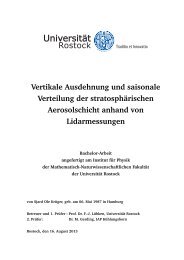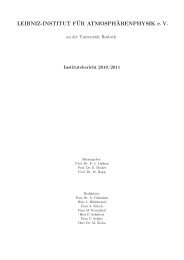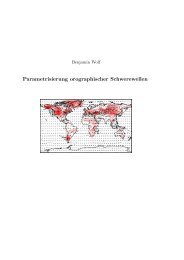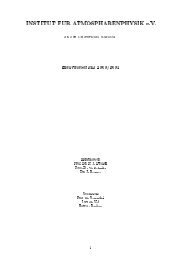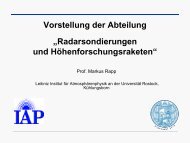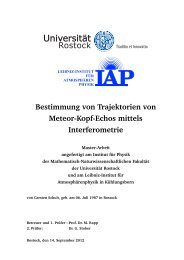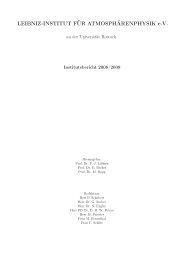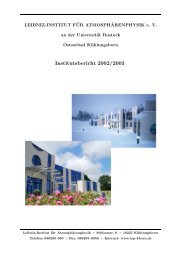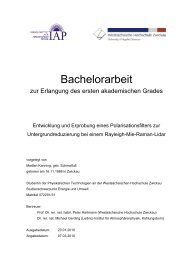Polar mesosphere summer echoes (PMSE): review of ... - HAL
Polar mesosphere summer echoes (PMSE): review of ... - HAL
Polar mesosphere summer echoes (PMSE): review of ... - HAL
You also want an ePaper? Increase the reach of your titles
YUMPU automatically turns print PDFs into web optimized ePapers that Google loves.
M. Rapp and F. J. Lübken: Review <strong>of</strong> <strong>PMSE</strong> 2619<br />
were the case, <strong>PMSE</strong> signal strength should be proportional<br />
to the charge number density (|Z A |N A ) and the square <strong>of</strong> the<br />
radius <strong>of</strong> these particles (rA 2 ) since the aerosol particle diffusion<br />
coefficient is expected to vary like 1/rA 2 (e.g., Cho et al.,<br />
1992). Taken together, the proxy P was defined as<br />
P = |Z A |N A · rA 2 . (1)<br />
Rapp et al. (2003c) showed that the proxy calculations<br />
indeed reproduce the observed mean <strong>PMSE</strong> pr<strong>of</strong>ile. Figure<br />
24 compares mean proxy pr<strong>of</strong>iles derived from averaging<br />
24 h model simulation runs for different background conditions<br />
(i.e., undisturbed and with two different gravity waves)<br />
with the mean <strong>PMSE</strong> signal strength as observed during the<br />
months June and July 2000. Evidently, the main features like<br />
altitude range and the altitude <strong>of</strong> the average <strong>PMSE</strong> maximum<br />
are nicely reproduced. In addition, the proxy calculations<br />
further suggested that individual <strong>PMSE</strong> (i.e., not averaged)<br />
should usually have their absolute maximum close to<br />
the lower edge <strong>of</strong> the layer due to the predicted dependence<br />
<strong>of</strong> the <strong>PMSE</strong> signal on the particle radius which is largest<br />
at the bottom <strong>of</strong> the ice cloud. This can be seen in Fig. 25<br />
where we show pr<strong>of</strong>iles <strong>of</strong> the proxy and the lidar backscatter<br />
ratio, the charge number density and the ice particle radius<br />
at an arbitrarily selected time during a model simulation.<br />
Evidently, the proxy pr<strong>of</strong>ile peaks at the altitude where<br />
the particles have grown largest, i.e., to radii <strong>of</strong> ∼50 nm at<br />
an altitude <strong>of</strong> 82 km, whereas the maximum particle charge<br />
number density occurs considerably higher, i.e., at 85 km instead<br />
<strong>of</strong> 82 km. In fact, a statistical analysis <strong>of</strong> <strong>PMSE</strong> data<br />
from three complete <strong>PMSE</strong> seasons studied with the ALWIN<br />
VHF radar confirms that the <strong>PMSE</strong> maximum is usually located<br />
in the lower part <strong>of</strong> the <strong>PMSE</strong> layer (see Fig. 8 in Rapp<br />
et al., 2003c).<br />
In summary, the overall good agreement <strong>of</strong> proxy- and<br />
<strong>PMSE</strong>-properties strongly supported the view that charged<br />
aerosol particles and their influence on electron diffusivity<br />
are the key physical process for our understanding <strong>of</strong> <strong>PMSE</strong>.<br />
This triggered Rapp and Lübken (2003a) to reconsider the<br />
corresponding theory. Their main results are discussed in the<br />
next section.<br />
3.5 The diffusion <strong>of</strong> electrons in the vicinity <strong>of</strong> charged particles<br />
revisited<br />
Based on the pioneer-work <strong>of</strong> Hill (1978), Rapp and Lübken<br />
(2003a) have recently reconsidered the diffusion <strong>of</strong> electrons<br />
in the presence <strong>of</strong> charged particles and positive ions. In<br />
such a plasma, the diffusion <strong>of</strong> the differently charged species<br />
is coupled through the Coulomb interaction between all the<br />
constituents. Since there are Coulomb forces between the<br />
positive ions and electrons on the one hand and charged particles<br />
and electrons on the other hand, it turns out that such a<br />
system possesses two distinct diffusion modes characterized<br />
by two different eigenvalues for the electron diffusion coefficient.<br />
In short, the one diffusion coefficient has the same<br />
Fig. 25. Model results <strong>of</strong> the proxy P (black,left), the calculated<br />
backscatter ratio that would be seen by a lidar operating at a wavelength<br />
<strong>of</strong> 532 nm (red, left), the charged particle number density<br />
(black, right) and the aerosol particle radius (red, right) (after Rapp<br />
et al., 2003c, copyright by the American Geophysical Union).<br />
order <strong>of</strong> magnitude as the ion diffusion coefficient but shows<br />
some dependence on the relative charge number density <strong>of</strong><br />
particles and electrons. The second diffusion coefficient is<br />
roughly given by the aerosol diffusion coefficient and varies<br />
with the aerosol radius like 1/r 2 A .<br />
The basic physical idea is now as follows: the charged<br />
aerosol particles are transported due to the turbulent velocity<br />
field and the accompanying shear (Batchelor, 1959). This<br />
transport, however, is equivalent to a charge current that must<br />
be compensated by an oppositely directed current <strong>of</strong> the electrons<br />
in order to maintain zero net current and local charge<br />
neutrality. This leads to anticorrelated spatial structures in<br />
the electron and charged particle distributions (see Sect. 4.4<br />
for experimental evidence for this morphology). The calculations<br />
<strong>of</strong> Rapp and Lübken (2003a) then showed that after<br />
a short initial time, the diffusion speed <strong>of</strong> the electron disturbances<br />
is entirely determined by the diffusion speed <strong>of</strong><br />
the charged aerosol particle disturbances. Note that unlike<br />
in Cho et al. (1992)’s treatment this general behaviour is almost<br />
independent <strong>of</strong> the parameter , i.e., the ratio between<br />
the charge number density <strong>of</strong> aerosol particles and the free<br />
electron number density 2 .<br />
These results have been independently confirmed by a<br />
comprehensive numerical investigation performed by Lie-<br />
Svendsen et al. (2003). These authors studied the temporal<br />
development <strong>of</strong> structures in the positive ion and electron<br />
number density distribution arising as a consequence <strong>of</strong><br />
a predefined structure in the distribution <strong>of</strong> aerosol particles<br />
2 Closer inspection <strong>of</strong> Cho et al. (1992)’s work actually shows<br />
that the 1-criterium is artificially created by an unphysical initial<br />
condition for their model calculations (see appendix B in Rapp and<br />
Lübken, 2003a, for a detailed discussion).<br />
www.atmos-chem-phys.org/acp/4/2601/ Atmos. Chem. Phys., 4, 2601–2633, 2004



